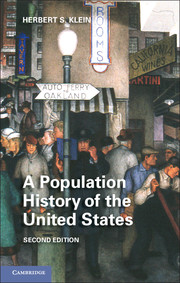Book contents
- Frontmatter
- Contents
- Graphs, Maps, and Tables
- Introduction to the Second Edition
- Introduction to the First Edition
- 1 Paleo–Indians, Europeans, and the Settlement of America
- 2 Colonization and Settlement of North America
- 3 The Early Republic to 1860
- 4 The Creation of an Industrial and Urban Society, 1860–1914
- 5 The Evolution of a Modern Population, 1914–1945
- 6 The Baby Boom and Bust and the New New Immigrants, 1945–1970
- 7 An Advanced Industrial Society, 1970–2011
- Appendix Tables, Graphs, and Maps
- Bibliography
- Index
- References
3 - The Early Republic to 1860
Published online by Cambridge University Press: 05 June 2012
- Frontmatter
- Contents
- Graphs, Maps, and Tables
- Introduction to the Second Edition
- Introduction to the First Edition
- 1 Paleo–Indians, Europeans, and the Settlement of America
- 2 Colonization and Settlement of North America
- 3 The Early Republic to 1860
- 4 The Creation of an Industrial and Urban Society, 1860–1914
- 5 The Evolution of a Modern Population, 1914–1945
- 6 The Baby Boom and Bust and the New New Immigrants, 1945–1970
- 7 An Advanced Industrial Society, 1970–2011
- Appendix Tables, Graphs, and Maps
- Bibliography
- Index
- References
Summary
The first 70 years of the new republic brought some very basic changes in the levels of fertility and mortality from those that had evolved in the 17th and 18th centuries. By 1800, a two-century-long pattern of declining fertility began, with each generation of women producing ever fewer children from the extraordinarily high rates of the late colonial period. At the same time, there was probably a rise in mortality rates, or at least some very sharp shifts, with no clear trends in annual mortality rates until well after the Civil War. There were even some clear indications of malnutrition in the immediate pre-Civil War period, a paradoxical finding given the steady and dramatic growth of the national population. There were also profound changes in migration in this period as the Atlantic slave trade ended in 1808 and the beginnings of mass European immigration to North America began to occur after 1840. It is the causes and consequences of these various factors that I examine in this chapter on the early republic to 1860.
The new republic of the United States began with a census and promised to maintain a periodical population count as part of its normal government operations. Thus began one of the oldest systematic censuses in World History, the decennial counting of the population of the United States. In the period of the 1770s to the 1780s, the political leaders of all the colonies came to the realization that a national census was needed. The movement for independence in the 1770s was accompanied by a major debate on the form that the new postcolonial republican government would take. The Articles of Confederation had already struggled with issues of representation and taxation. The state responsibilities for the public debt as well as of the nature of the state representation in the central government all rested on the question of population size.
- Type
- Chapter
- Information
- A Population History of the United States , pp. 61 - 94Publisher: Cambridge University PressPrint publication year: 2012



